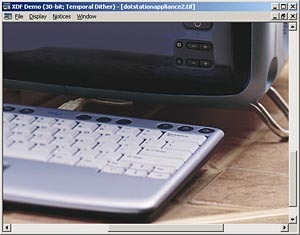Brighten up your life: True 30-bit picture output for the PC
Chicago (IL) - A software developer claims to have discovered a technique to display true 30-bit graphics on a PC - without the traditionally required support of a high-end graphics card. The software bumps the maximum numbers of colors displayed on a monitor from 16.7 million to more than 1 billion.
So, what is special about 30-bit, one may ask. In the end, Windows allows users to configure output in 32-bit, right? Well, not quite.
32-bit in Windows basically represents eight bit for every color channel (Red, Green, Blue) plus an additional alpha channel. This alpha channel also is eight bit for transparency. The result, however, is still 24-bit of color. This represents 256 color steppings for each channel, resulting in a total of 16,777,216 colors (256 x 256 x 256), often abbreviated as 16.7 million colors. This technique is also referred to as "32-bit alignment" of 24-bit information.
Software developer Ron Silvas says that a fairly simple technique has allowed him to display every color channel in 10-bit, with 1024 steppings for each channel. This increases the maximum amount of displayable colors in a picture to a staggering 1,073,741,824 (1024 x 1024 x1024). "Experts believe that the human eye can distinguish between 600 and 700 steppings within a color. This explains why steppings can be visible even in high-resolution 24-bit images. 30-bit is beyond that level, steppings are not visible anymore." While 30-bit does not often provide a dramatic increase in picture quality for everyday applications, especially graphic artists can take advantage of this technology to approach a more perfect image with no noise and purer colors.
So far, the display of 30-bit images has required special hardware such as Matrox' Parhelia products.
Silvas has not developed a commercial version of his software technology, but offers a download of a demo in exchange for a donation via Paypal. The demo, named XDF (Extended Display Fidelity), is a software implementation of temporal dithering and allows viewing images in 24-bit and 30-bit. Temporal dithering is a technique that synthesizes otherwise unattainable color shades by rapidly alternating between the two nearest, available shades. Silvas said that he found that their temporal dithering can successfully extend 24-bit color to 27-bit color on computer displays with lower refresh rates, such as LCD displays, and can extend up to 30-bit color on displays with higher refresh rates.
Since this technology could be easily implemented in every graphic software, Silvas said he abandoned his plan to develop a commercial product. "I think the project findings and the ability to play with and experience the demo's various color depth extensions and such are interesting enough to be for people. So I wrote up appropriate documentation, and now I'm making the demo available in exchange for a donation."
Get Tom's Hardware's best news and in-depth reviews, straight to your inbox.
The XDF application Silvas offers, allows users to import their TIF images and view them in more realistic color and enables for example garphic artists and animators to preview images without noise and color stepping.
"I've found the differences between 24- and 30-bit color tend to only be noticeable in certain classes of images and, even then, tend to be quite subtle, so I expect serious interest in 30-bit color to mostly be limited to digital artists and those similarly involved with computer graphics," Silvas said. "I think graphics enthusiasts, digital artists and graphics professionals would enjoy the opportunity to use the demo to experience and evaluate 30-bit color for themselves, on their own machines, with the built-in samples and their own 48-bit TIFFs."
"24 bit is good enough for most applications," Silvas said. But fortunately, if "good enough" was ever good enough for the enthusiast computer user, hardware and software manufacturers would have trouble finding buyers for every new product. Silvas said that he is undecided yet, but may offer a commercial version of his technology.

Wolfgang Gruener is an experienced professional in digital strategy and content, specializing in web strategy, content architecture, user experience, and applying AI in content operations within the insurtech industry. His previous roles include Director, Digital Strategy and Content Experience at American Eagle, Managing Editor at TG Daily, and contributing to publications like Tom's Guide and Tom's Hardware.
